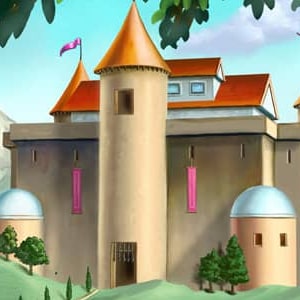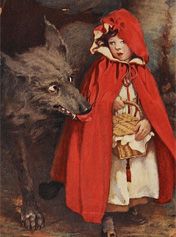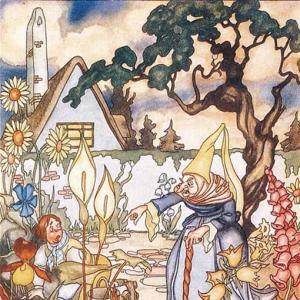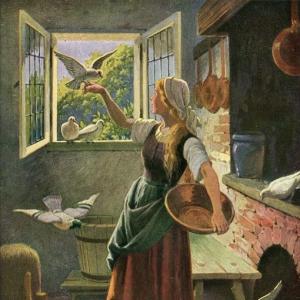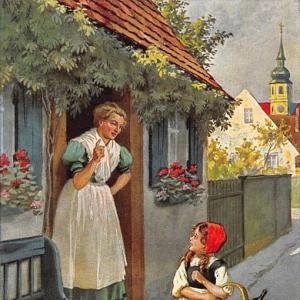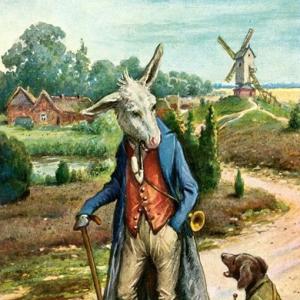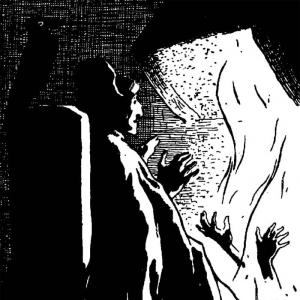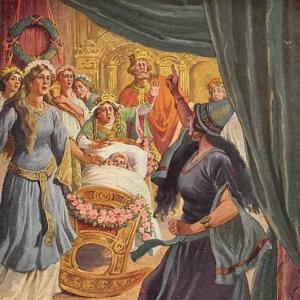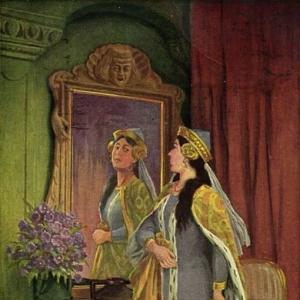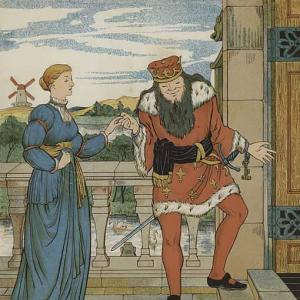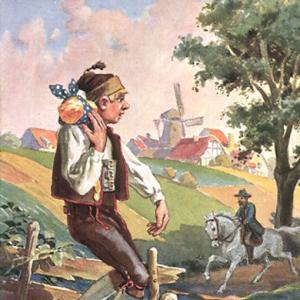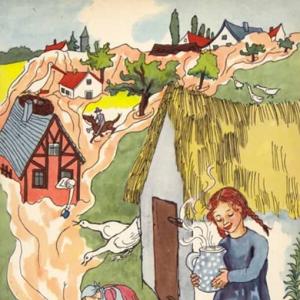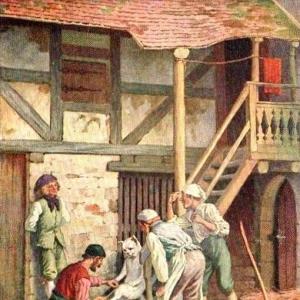Reading time for children: 12 min
Many, many years ago lived an emperor, who thought so much of new clothes that he spent all his money in order to obtain them. His only ambition was to be always well dressed. He did not care for his soldiers, and the theatre did not amuse him. The only thing, in fact, he thought anything of was to drive out and show a new suit of clothes. He had a coat for every hour of the day; and as one would say of a king „He is in his cabinet,“ so one could say of him, „The emperor is in his dressing-room.“
The great city where he resided was very gay; every day many strangers from all parts of the globe arrived. One day two swindlers came to this city. They made people believe that they were weavers, and declared they could manufacture the finest cloth to be imagined. Their colours and patterns, they said, were not only exceptionally beautiful, but the clothes made of their material possessed the wonderful quality of being invisible to any man who was unfit for his office or unpardonably stupid.
„That must be wonderful cloth,“ thought the emperor. „If I were to be dressed in a suit made of this cloth I should be able to find out which men in my empire were unfit for their places, and I could distinguish the clever from the stupid. I must have this cloth woven for me without delay.“ And he gave a large sum of money to the swindlers, in advance, that they should set to work without any loss of time. They set up two looms, and pretended to be very hard at work, but they did nothing whatever on the looms. They asked for the finest silk and the most precious gold-cloth; all they got they did away with, and worked at the empty looms till late at night.
„I should very much like to know how they are getting on with the cloth,“ thought the emperor. But he felt rather uneasy when he remembered that he who was not fit for his office could not see it. Personally, he was of opinion that he had nothing to fear, yet he thought it advisable to send somebody else first to see how matters stood. Everybody in the town knew what a remarkable quality the stuff possessed, and all were anxious to see how bad or stupid their neighbours were.
„I shall send my honest old minister to the weavers,“ thought the emperor. „He can judge best how the stuff looks, for he is intelligent, and nobody understands his office better than he.“
The good old minister went into the room where the swindlers sat before the empty looms. „Heaven preserve us!“ he thought, and opened his eyes wide, „I cannot see anything at all,“ but he did not say so.
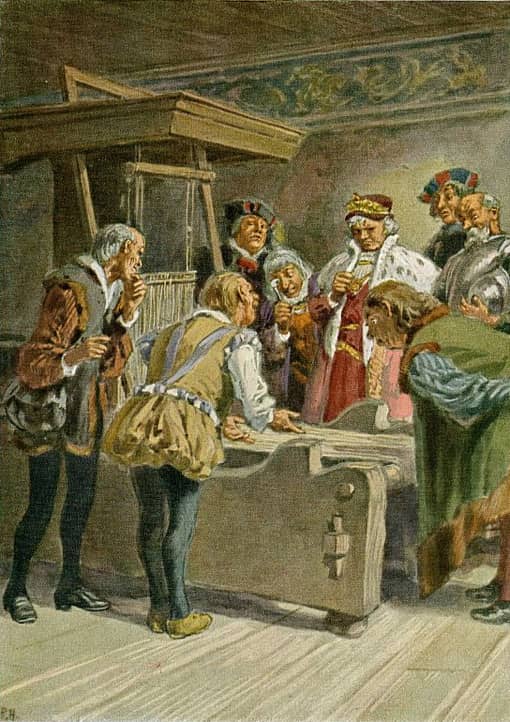 Image: Paul Hey (1867 – 1952)
Image: Paul Hey (1867 – 1952)Both swindlers requested him to come near, and asked him if he did not admire the exquisite pattern and the beautiful colours, pointing to the empty looms. The poor old minister tried his very best, but he could see nothing, for there was nothing to be seen. „Oh dear,“ he thought, „can I be so stupid? I should never have thought so, and nobody must know it! Is it possible that I am not fit for my office? No, no, I cannot say that I was unable to see the cloth.“
„Now, have you got nothing to say?“ said one of the swindlers, while he pretended to be busily weaving.
„Oh, it is very pretty, exceedingly beautiful,“ replied the old minister looking through his glasses. „What a beautiful pattern, what brilliant colours! I shall tell the emperor that I like the cloth very much.“
„We are pleased to hear that,“ said the two weavers, and described to him the colours and explained the curious pattern. The old minister listened attentively, that he might relate to the emperor what they said; and so he did.
Now the swindlers asked for more money, silk and gold-cloth, which they required for weaving. They kept everything for themselves, and not a thread came near the loom, but they continued, as hitherto, to work at the empty looms.
Soon afterwards the emperor sent another honest courtier to the weavers to see how they were getting on, and if the cloth was nearly finished. Like the old minister, he looked and looked but could see nothing, as there was nothing to be seen.
„Is it not a beautiful piece of cloth?“ asked the two swindlers, showing and explaining the magnificent pattern, which, however, did not exist.
„I am not stupid,“ said the man. „It is therefore my good appointment for which I am not fit. It is very strange, but I must not let any one know it;“ and he praised the cloth, which he did not see, and expressed his joy at the beautiful colours and the fine pattern. „It is very excellent,“ he said to the emperor.
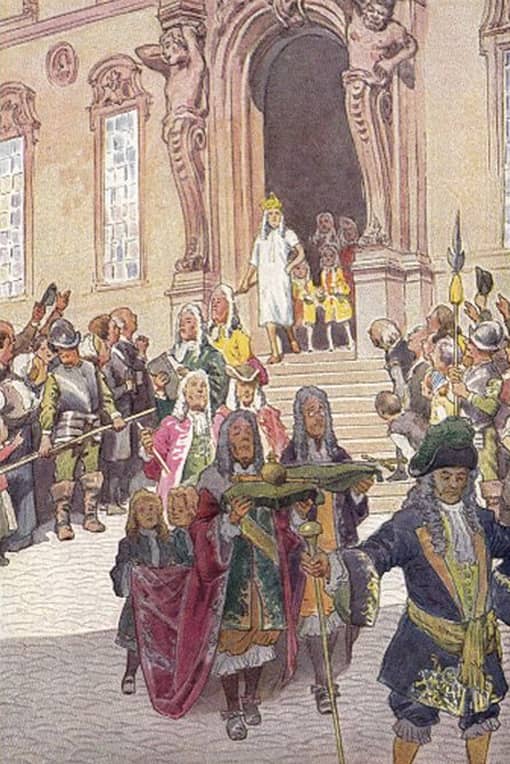 Image: Paul Hey (1867 – 1952)
Image: Paul Hey (1867 – 1952)Everybody in the whole town talked about the precious cloth. At last the emperor wished to see it himself, while it was still on the loom. With a number of courtiers, including the two who had already been there, he went to the two clever swindlers, who now worked as hard as they could, but without using any thread.
„Is it not magnificent?“ said the two old statesmen who had been there before. „Your Majesty must admire the colours and the pattern.“ And then they pointed to the empty looms, for they imagined the others could see the cloth.
„What is this?“ thought the emperor, „I do not see anything at all. That is terrible! Am I stupid? Am I unfit to be emperor? That would indeed be the most dreadful thing that could happen to me.“
„Really,“ he said, turning to the weavers, „your cloth has our most gracious approval;“ and nodding contentedly he looked at the empty loom, for he did not like to say that he saw nothing. All his attendants, who were with him, looked and looked, and although they could not see anything more than the others, they said, like the emperor, „It is very beautiful.“ And all advised him to wear the new magnificent clothes at a great procession which was soon to take place. „It is magnificent, beautiful, excellent,“ one heard them say; everybody seemed to be delighted, and the emperor appointed the two swindlers „Imperial Court weavers.“
The whole night previous to the day on which the procession was to take place, the swindlers pretended to work, and burned more than sixteen candles. People should see that they were busy to finish the emperor’s new suit. They pretended to take the cloth from the loom, and worked about in the air with big scissors, and sewed with needles without thread, and said at last: „The emperor’s new suit is ready now.“
The emperor and all his barons then came to the hall. The swindlers held their arms up as if they held something in their hands and said: „These are the trousers!“ – „This is the coat!“ and „Here is the cloak!“ and so on. „They are all as light as a cobweb, and one must feel as if one had nothing at all upon the body; but that is just the beauty of them.“
„Indeed!“ said all the courtiers; but they could not see anything, for there was nothing to be seen.
„Does it please your Majesty now to graciously undress,“ said the swindlers, „that we may assist your Majesty in putting on the new suit before the large looking-glass?“
The emperor undressed, and the swindlers pretended to put the new suit upon him, one piece after another; and the emperor looked at himself in the glass from every side.
„How well they look! How well they fit!“ said all. „What a beautiful pattern! What fine colours! That is a magnificent suit of clothes!“
The master of the ceremonies announced that the bearers of the canopy, which was to be carried in the procession, were ready.
„I am ready,“ said the emperor. „Does not my suit fit me marvellously?“ Then he turned once more to the looking-glass, that people should think he admired his garments.
The chamberlains, who were to carry the train, stretched their hands to the ground as if they lifted up a train, and pretended to hold something in their hands. They did not like people to know that they could not see anything.
The emperor marched in the procession under the beautiful canopy, and all who saw him in the street and out of the windows exclaimed: „Indeed, the emperor’s new suit is incomparable! What a long train he has! How well it fits him!“ Nobody wished to let others know he saw nothing, for then he would have been unfit for his office or too stupid. Never emperor’s clothes were more admired.
„But he has nothing on at all,“ said a little child at last.
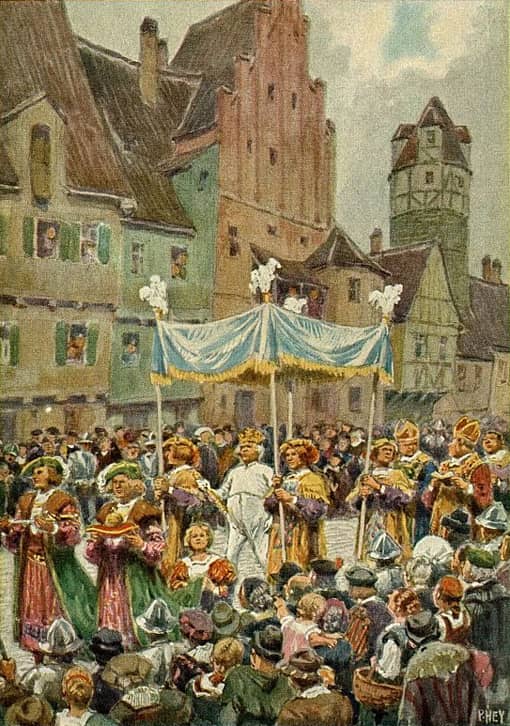 Image: Paul Hey (1867 – 1952)
Image: Paul Hey (1867 – 1952)„Good heavens! listen to the voice of an innocent child,“ said the father, and one whispered to the other what the child had said.
„But he has nothing on at all,“ cried at last the whole people. That made a deep impression upon the emperor, for it seemed to him that they were right; but he thought to himself, „Now I must bear up to the end.“ And the chamberlains walked with still greater dignity, as if they carried the train which did not exist.
 Learn languages. Double-tap on a word.Learn languages in context with Childstories.org and Deepl.com.
Learn languages. Double-tap on a word.Learn languages in context with Childstories.org and Deepl.com.Backgrounds
Interpretations
Adaptions
Summary
Linguistics
„The Emperor’s New Clothes“ is a short story written by Danish author Hans Christian Andersen, who is best known for his fairy tales. The story was first published in 1837 as part of Andersen’s third collection of tales for children. Hans Christian Andersen was born on April 2, 1805, in Odense, Denmark, and died on August 4, 1875, in Copenhagen. Besides „The Emperor’s New Clothes,“ Andersen is famous for many other classic fairy tales, such as „The Little Mermaid,“ „The Ugly Duckling,“ „The Snow Queen,“ „Thumbelina,“ and „The Princess and the Pea.“
Andersen’s stories often contain moral lessons and have been translated into numerous languages, making him one of the most widely read authors in the world. His stories have been adapted into various forms of media, including plays, films, and animated movies. Andersen’s works are known for their imaginative plots, memorable characters, and emotional depth, often touching on themes of transformation, innocence, and the human experience.
„The Emperor’s New Clothes“ stands out as a satirical tale that critiques vanity, pride, and societal conformity. The story’s enduring popularity can be attributed to its timeless message, which continues to resonate with readers today. It serves as a reminder to question authority, be honest, and value truth over appearances.
„The Emperor’s New Clothes“ has been interpreted in various ways, often highlighting themes such as vanity, pride, and the fear of appearing foolish. Here are some common interpretations of the story.
The danger of vanity and pride: The emperor’s obsession with his appearance and clothing leads to his ultimate humiliation. His vanity makes him an easy target for the swindlers and results in a costly mistake.
The power of social conformity: The story illustrates how people are often afraid to challenge the status quo or express a dissenting opinion for fear of ridicule or being seen as unfit. Both the ministers and the townspeople pretend to see the non-existent clothes to avoid admitting their inability to see them.
The importance of critical thinking and questioning authority: The child in the story represents innocence and the ability to see the truth without the fear of social consequences. The child’s honest observation ultimately exposes the collective delusion, emphasizing the importance of questioning what we’re told and not blindly accepting authority.
The manipulation of the masses: The swindlers in the story represent manipulative individuals who take advantage of others‘ weaknesses to deceive and control them. They prey on the emperor’s vanity and the people’s fear of appearing foolish, showcasing the dangers of falling prey to such deception.
The courage to speak the truth: The story highlights the importance of speaking the truth, even when it’s uncomfortable or unpopular. The child’s courage to say what others were afraid to voice eventually leads to the truth being acknowledged by everyone.
Overall, „The Emperor’s New Clothes“ serves as a cautionary tale that encourages critical thinking, honesty, and the questioning of authority. It warns against the pitfalls of vanity, pride, and social conformity, reminding readers to value truth and maintain their integrity.
„The Emperor’s New Clothes“ has been adapted into various forms of media over the years, including:
Films: There have been numerous film adaptations of the story, both live-action and animated. Some notable examples include the 1953 animated short film by Walt Disney Productions, the 1987 television film by Danny Kaye, and the 2001 animated film by Toonz Animation India.
Stage plays and musicals: „The Emperor’s New Clothes“ has also been adapted into stage plays and musicals, often with added songs and dance numbers. Some notable examples include the 1956 musical by Jay Thompson, the 2006 musical by Robert Lopez and Jeff Marx, and the 2012 play by Kathryn Schultz Miller.
Children’s books: The story has been adapted into numerous children’s books, often with illustrations that bring the characters and setting to life. Some notable examples include the 1964 book by Remy Charlip, the 1985 book by Robert Sabuda, and the 2018 book by Hans Christian Andersen and Svend Otto S.
TV shows: „The Emperor’s New Clothes“ has also been adapted into various television shows, including an episode of the animated series „Happily Ever After: Fairy Tales for Every Child“ and an episode of the animated series „The Fairy Tale Detectives“.
Other adaptations: In addition to these adaptations, „The Emperor’s New Clothes“ has also been adapted into other forms of media, including radio dramas, comic books, and even video games.
Overall, the enduring popularity of „The Emperor’s New Clothes“ has led to numerous adaptations that have brought the story to new audiences and reimagined it for new generations.
„The Emperor’s New Clothes“ is a fairy tale by Hans Christian Andersen about a vain emperor who values his appearance above all else. He becomes obsessed with having the finest clothes and spends all his money on them. One day, two swindlers posing as weavers claim to have invented a unique fabric that is invisible to those who are unfit for their position or unintelligent. The emperor, intrigued by this proposition, hires the swindlers to make him a suit from this fabric.
The swindlers pretend to work on the looms, asking for expensive materials which they pocket for themselves. The emperor sends two ministers to check on the progress of the suit. Both ministers are unable to see the non-existent fabric but, afraid to admit their incompetence, praise the cloth and report back to the emperor.
Eventually, the emperor visits the swindlers, and, like his ministers, pretends to see the fabric to avoid appearing unfit for his position. He then parades through the town wearing the „new clothes,“ while his subjects, also unwilling to admit their own incompetence, praise the invisible garment. Eventually, a young child points out that the emperor is, in fact, wearing nothing, and the crowd acknowledges this truth. The emperor, realizing the people’s opinion, continues the procession, attempting to maintain his dignity despite the humiliating revelation.
Linguistic analysis of „The Emperor’s New Clothes“ by Hans Christian Andersen reveals several interesting aspects of the text’s language and style:
Narrative Technique: Andersen employs a third-person omniscient narrator, which provides an all-knowing perspective on the characters‘ thoughts and actions. This technique allows for insightful commentary on the folly of the emperor and his subjects while maintaining a detached tone.
Syntax and Diction: The language of the story is straightforward and clear, employing simple sentence structures and accessible vocabulary. This simplicity is characteristic of fairy tales and helps to convey the story’s moral lessons clearly to both children and adults. The diction used is formal enough to capture the story’s traditional and historical setting, yet it remains accessible.
Repetition: There is a notable use of repetition, particularly in phrases like „I cannot see anything at all,“ which emphasizes the fear and denial experienced by the characters when confronted with the invisible cloth. This repetition highlights the theme of self-deception and societal pressure.
Irony: Irony is a dominant feature throughout the text. The story revolves around the idea that the „invisible“ clothes are a test of competence and intelligence, yet all characters pretend to see them to avoid being deemed unfit or stupid. The ultimate irony is that the emperor parades naked, believing he is dressed in magnificent clothes. This irony critiques vanity, pride, and the human tendency to conform under social pressure.
Symbolism: Clothing in this tale is symbolic of status, competence, and intelligence. The invisible cloth becomes a metaphor for the façade people maintain to avoid judgment. The emperor’s nakedness in the end symbolizes exposure to truth and vulnerability.
Dialogue: Dialogue is used effectively to convey the characters‘ internal conflicts and societal pressures. When the swindlers describe the nonexistent cloth, and the characters agree with them, it showcases their willingness to conform and deceive themselves to maintain their reputation.
Characterization: Through linguistic cues, Andersen characterizes the emperor as vain and concerned with appearances, the swindlers as cunning and manipulative, and the courtiers as sycophantic and fearful. The child, who speaks truthfully about the emperor’s nakedness, represents innocence and honesty, acting as a moral compass.
Theme of Truth and Perception: The recurring theme is the conflict between truth and perception. The story exposes how easily people can be influenced by the opinions of others and lose sight of the truth.
Moral Lesson: Andersen’s tale subtly critiques the foolishness of vanity and the dangers of collective denial. It reinforces the importance of honesty and the courage to speak the truth, even when it contradicts popular belief.
Overall, Andersen’s language effectively combines simplicity and wit to craft a timeless fairy tale that critiques societal norms and human behavior.
Information for scientific analysis
Fairy tale statistics | Value |
|---|---|
| Translations | DE, EN, EL, DA, ES, FR, IT, NL, RO |
| Readability Index by Björnsson | 33.2 |
| Flesch-Reading-Ease Index | 75.3 |
| Flesch–Kincaid Grade-Level | 6.7 |
| Gunning Fog Index | 10 |
| Coleman–Liau Index | 9.1 |
| SMOG Index | 10.3 |
| Automated Readability Index | 6.4 |
| Character Count | 8.717 |
| Letter Count | 6.718 |
| Sentence Count | 100 |
| Word Count | 1.589 |
| Average Words per Sentence | 15,89 |
| Words with more than 6 letters | 275 |
| Percentage of long words | 17.3% |
| Number of Syllables | 2.167 |
| Average Syllables per Word | 1,36 |
| Words with three Syllables | 150 |
| Percentage Words with three Syllables | 9.4% |



